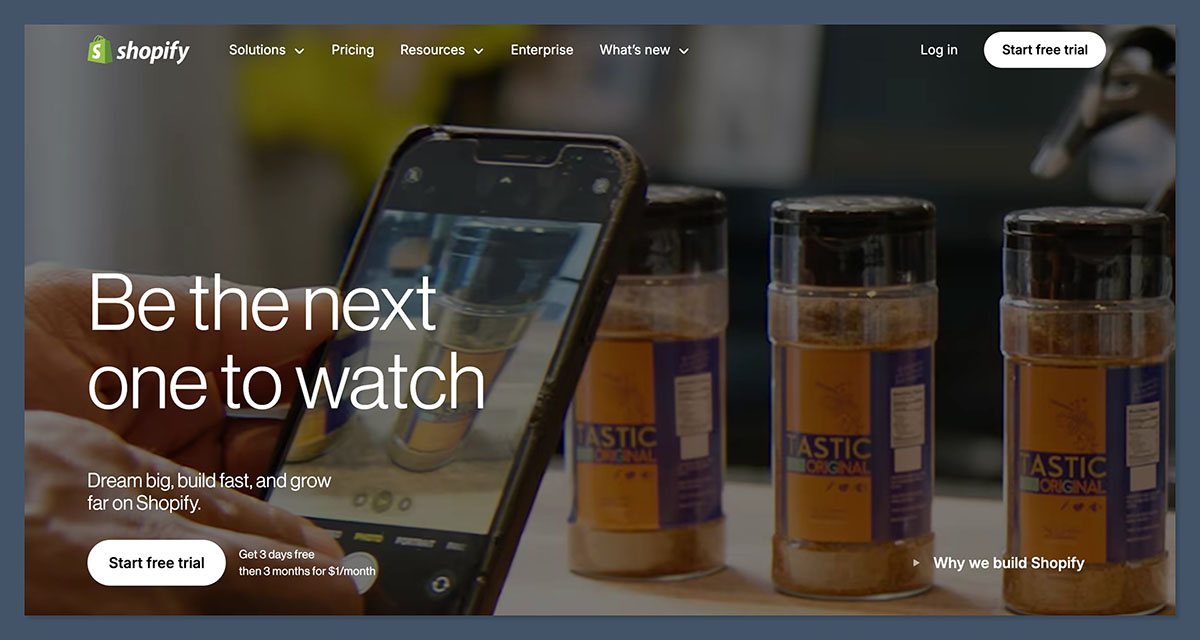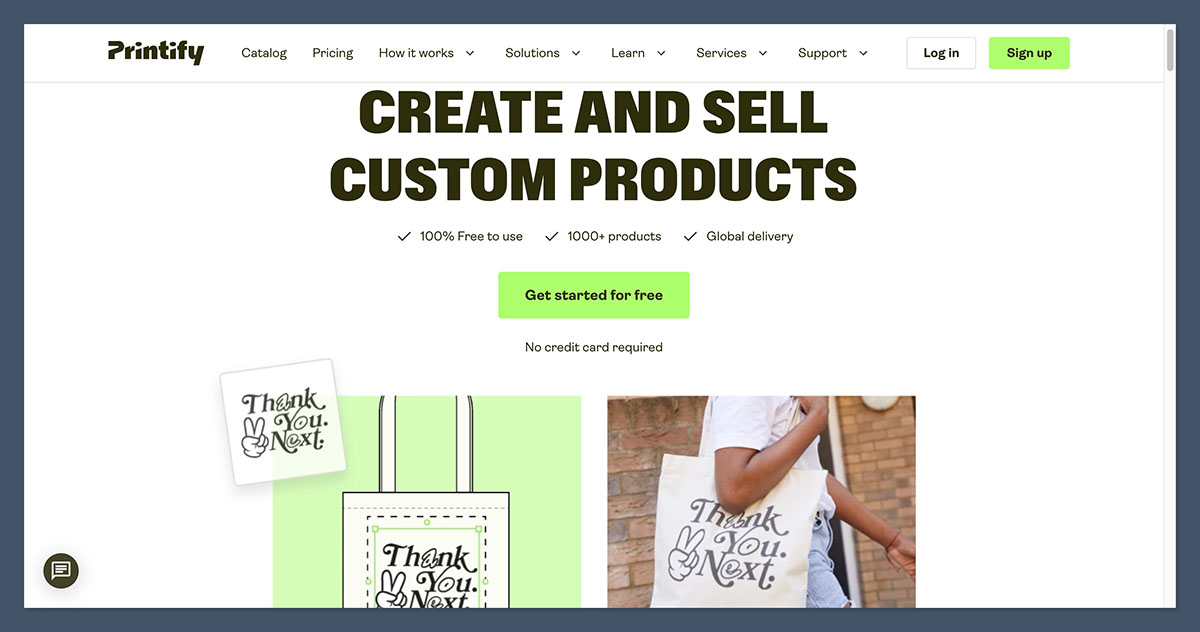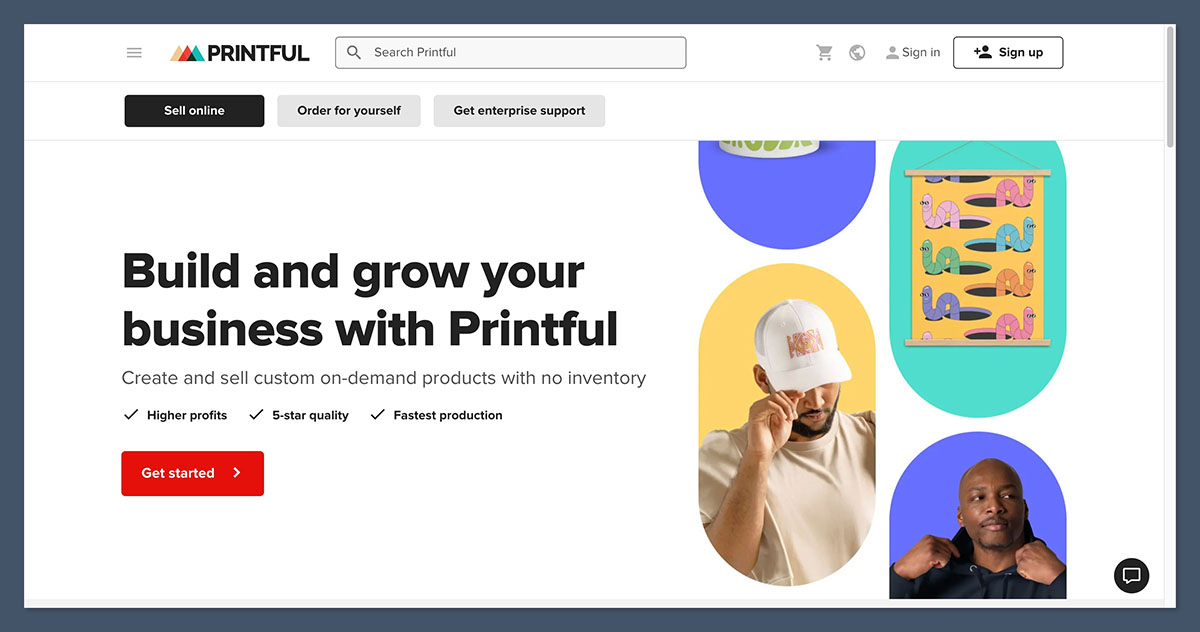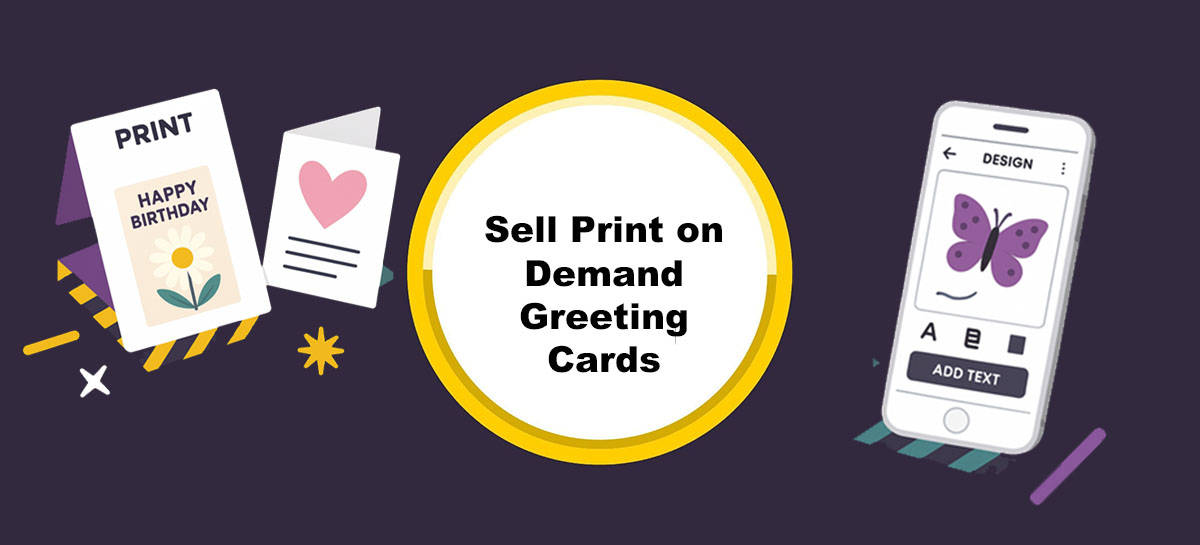Selling print on demand greeting cards is a low-risk way to test product ideas and tap into seasonal trends without holding inventory.
With the right platform and designs, greeting cards can become a steady income stream. But the opportunity comes with clear limitations—mainly low margins and heavy competition.
In this guide, we’ll cover how to get started, where to sell, what tools to use, and real pros and cons. You’ll also see pricing breakdowns, market data, and what makes certain greeting cards actually sell.
Table of Contents
- What Is Print on Demand for Greeting Cards?
- Where to Sell Print on Demand Greeting Cards
- Best Print on Demand Greeting Card Companies
- How to Create Greeting Card Designs That Sell
- Pros and Cons of Selling POD Greeting Cards
- Pricing and Profit Margins
- SEO for Greeting Card Listings
- Niche and Seasonal Opportunities
- Tools for Design, Fulfillment, and Research
- Common Mistakes to Avoid
- Is Selling Greeting Cards with POD Worth It?
1. What Is Print on Demand for Greeting Cards?
Print on demand (POD) is a fulfillment method where products are only printed and shipped after a customer places an order.
There’s no upfront inventory, no minimum order quantities, and no packing or shipping handled by the seller.
For greeting cards, this includes a range of formats:
- Folded greeting cards with envelopes
- Flat cards or postcards
- Customisable message cards
Most POD suppliers offer standard features like:
- Single or double-sided printing
- Matte or gloss finishes
- Multiple card sizes
- Optional envelope inclusion
You upload your design, connect a store like Etsy or Shopify, and when a customer buys, the POD company prints and ships the order directly to them.
The next step is choosing a supplier. Each POD provider offers different print quality, pricing, and integrations. Let’s look at the most reliable options for selling greeting cards.
2. Where to Sell Print on Demand Greeting Cards
Choosing the right platform to sell your greeting cards depends on your goals, experience, and how much control you want over your business.
While marketplaces like Etsy and Redbubble offer easy entry and built-in traffic, they also come with fees, policy changes, and limited branding control.
If you’re looking to build something sustainable, Shopify is usually the best long-term option—especially once you start getting consistent traffic and sales.
Shopify — Best for Long-Term Control and Branding

Shopify gives you full control over your store, brand, customer data, and pricing. You’re not competing directly with other sellers on a marketplace page, and you can build a real customer base over time.
Pros:
- Total control over your storefront, product pages, branding, and domain
- Access to customer emails for remarketing, upsells, and email flows
- No listing or transaction fees from a marketplace
- Easy integrations with Printify, Printful, Gooten, Gelato, and more
- Higher average order value potential through bundling and upsells
Cons:
- No built-in traffic—you have to bring your own audience
- Monthly fee of $39/month for the Basic plan
- Requires some setup (custom domain, theme, product pages)
If you’re serious about building a brand—even a small one—Shopify gives you full ownership. You’re not at the mercy of algorithm changes, platform fee hikes, or listing removals.
It’s especially valuable if you want to scale into other products later (like mugs, notebooks, or t-shirts) or offer custom bundles for holidays.
If you’re planning to take your print on demand business seriously, Shopify is the best place to build it.
Right now, new users can get started for just $1/month for the first 3 months, giving you time to:
- Set up your storefront
- Upload your card designs
- Test SEO and start driving traffic
- Keep your overhead near zero while you learn
Start your Shopify store today and take control of your own brand: Start for $1/month
You’ll own the platform, your customers, and your future growth—not just rent space on someone else’s marketplace.
Etsy — Easy to Start, But Less Control
Etsy is still one of the most popular marketplaces for greeting cards. It’s designed for handmade, artistic, and personalised products—and shoppers come with intent to buy.
Pros:
- Massive built-in traffic and seasonal spikes
- Great fit for personalised or funny card designs
- Fast integration with Printify and Printful
- Etsy shoppers are already primed to buy gifts and cards
Cons:
- Rising fees (6.5% transaction fee, $0.20 per listing, plus payment processing and shipping fees)
- Limited control over branding and customer data
- You’re one of thousands of similar listings competing for attention
- Algorithm updates and policy changes can impact visibility overnight
Etsy works best for testing new designs, finding product-market fit, and driving early sales. But many sellers eventually outgrow it or shift to their own store once they want more freedom and margin.
Redbubble / Zazzle / Society6 — Set and Forget Marketplaces
These marketplaces make it easy to upload designs and start selling without needing your own store or customer service setup.
Pros:
- No upfront cost to start
- Easy to apply designs across multiple products
- Platforms handle fulfilment, customer service, and logistics
Cons:
- Very low profit margins (cards often earn $0.25–$1.00 per sale)
- No access to buyer data or ability to build a following
- Little to no design flexibility—template-based listings
- High competition across all categories
These platforms are ideal if you’re testing ideas or want passive income from old designs, but not if you’re building a focused business.
Amazon (via Merch by Amazon or Seller Central) — High Traffic, High Competition
Amazon has huge reach, especially around holidays, but it’s harder to manage without experience.
Pros:
- Access to millions of shoppers worldwide
- Excellent for targeting holiday card spikes (Christmas, Valentine’s, etc.)
- Potential for recurring sales once listings rank
Cons:
- Strict product listing guidelines
- High competition and limited room for creative branding
- Requires either invitation to Merch by Amazon or a full Seller Central account
- Paid ads are often necessary to gain traction
Amazon can be worth it if you’re familiar with ecommerce or already selling other POD items. But it’s not ideal for beginners focused solely on greeting cards.
Final Recommendation:
| Platform | Best For | Ownership | Profit Potential | Ease of Start |
|---|---|---|---|---|
| Shopify | Building a brand, full control | High | High | Moderate |
| Etsy | Testing designs, early sales | Low | Medium | Easy |
| Redbubble | Passive uploads, design testing | Low | Low | Very Easy |
| Amazon | Holiday card spikes, high-volume traffic | Low | Medium | Advanced |
If you’re just starting out, Etsy may help you learn fast.
But if you want to build a long-term business with stable margins and control, Shopify is the better investment.
3. Best Print on Demand Greeting Card Companies
Choosing the right print on demand company for greeting cards depends on your priorities—whether that’s pricing, print quality, shipping speed, or platform integration.
Here’s a breakdown of the top providers currently used by ecommerce sellers.
1. Printify

Printify is one of the most popular choices for greeting cards due to its broad network of print providers and competitive pricing.
Pros:
- Large selection of suppliers
- Integrates with Etsy, Shopify, WooCommerce
- Allows you to choose a print provider by location
Cons:
- Print quality varies depending on provider
- Some users report inconsistent packaging
Pricing:
- Greeting cards from $1.50–$2.00 per unit
- Optional Printify Premium plan for $29/month (gives 20% product discount)
Best for: Sellers who want low costs and flexibility in choosing suppliers.
2. Printful

Printful is known for high-quality printing and packaging. It’s slightly more expensive but often used by brands focused on presentation.
Pros:
- High-quality print and materials
- Reliable fulfillment and shipping times
- Custom branding options (e.g., pack-ins, branded labels)
Cons:
- Higher base prices than competitors
- Fewer card size options than others
Pricing:
- Greeting cards typically $2.00–$2.50
- Shipping starts at $0.75–$1.25 (US)
Best for: Sellers prioritizing quality and brand control over profit margin.
3. Gooten
Gooten offers a wide range of products, including greeting cards, with easy Shopify integration. It’s less mainstream than Printify or Printful but still a solid option.
Pros:
- Competitive pricing
- Strong backend dashboard for managing orders
- Decent quality control
Cons:
- Fewer integrations (mainly Shopify + API)
- Slower customer support
Pricing:
- Greeting cards from $1.80–$2.20 per unit
Best for: Shopify users who want an alternative to Printify with good operational tools.
4. Zazzle
Zazzle is both a POD provider and a marketplace. You upload designs directly to Zazzle’s platform and earn royalties on sales.
Pros:
- Built-in traffic
- Huge greeting card product catalog
- Easy setup, no external store needed
Cons:
- You don’t own the customer
- Royalties are low (10–15% standard)
Pricing:
- You set your royalty %; base pricing is fixed by Zazzle
Best for: Designers who want passive income from an existing marketplace.
5. Redbubble
Similar to Zazzle, Redbubble lets you upload designs to a marketplace that handles fulfillment.
Pros:
- No setup or upfront costs
- Traffic is built-in
- Easy to list across multiple products
Cons:
- Low royalties per card ($0.25–$1.00 typical)
- Limited card customization options
Pricing:
- Seller earnings based on markup you set (base prices fixed)
Best for: Artists and hobbyists who want to test designs with no overhead.
6. Gelato
Gelato is growing fast as a POD solution with local fulfillment centers in 30+ countries. They offer greeting cards with fast regional shipping.
Pros:
- Local printing = faster shipping in many countries
- Better sustainability practices
- Integrates with Shopify, Etsy, WooCommerce
Cons:
- Higher shipping costs in some regions
- Smaller product range than competitors
Pricing:
- Greeting cards from $2.00–$2.40
- Local shipping rates vary by country
Best for: International sellers or eco-conscious brands.
Comparison Table
| Company | Starting Price | Shipping Cost (US) | Integrations | Quality | Best For |
|---|---|---|---|---|---|
| Printify | $1.50–$2.00 | $0.75–$1.25 | Etsy, Shopify, Woo | Varies | Budget-friendly and flexible setup |
| Printful | $2.00–$2.50 | $0.75–$1.25 | Etsy, Shopify, Woo | High | Branding and premium look |
| Gooten | $1.80–$2.20 | $0.85–$1.35 | Shopify | Consistent | Shopify sellers with backend focus |
| Zazzle | Royalty model | Included in price | Zazzle only | Moderate | Passive income via marketplace |
| Redbubble | Royalty model | Included in price | Redbubble only | Moderate | Art-focused sellers |
| Gelato | $2.00–$2.40 | Varies by region | Etsy, Shopify, Woo | High | International/local POD |
Quick Recommendations:
- Use Printify if you want flexibility and the best shot at high margins
- Use Printful if you’re building a long-term brand with strong packaging
- Try Zazzle or Redbubble for passive designs with no upfront costs
- Use Gelato for fast local shipping in non-US markets
3. How to Create Greeting Cards That Sell
Creating a greeting card that looks good is easy. Creating one that sells takes more thought. Design plays a big role, but so does understanding the customer, the occasion, and the context in which your card will be used.
Cards are emotional products. They’re bought to mark a moment—funny, meaningful, awkward, or heartfelt.
And buyers want that emotion reflected back at them quickly. That’s why theme, tone, and clarity are more important than clever visuals alone.
What Makes a Greeting Card Sell?
The best-selling greeting cards usually fall into a few predictable categories, but success comes from how you approach the theme, not just picking one at random.
Top-Selling Themes (and Why They Work)
- Humour and sarcasm
These cards stand out because they’re direct and relatable. People want to give cards that reflect their relationships—and not everyone wants something sentimental. Cards with dry humour, swearing, or cheeky jokes tend to perform well, especially on platforms like Etsy. - Milestones (birthdays, weddings, graduations)
These are evergreen categories. But instead of going broad (e.g. “Happy Birthday”), niching down makes a difference. Try: “Happy Divorce-iversary” or “Congrats on Your Midlife Crisis.” - Holidays (Christmas, Valentine’s, Mother’s Day)
These cards spike in traffic once or twice a year, and customers often buy them in bulk. Offer bundles. Target specific audiences: “Christmas Card from the Dog,” “Valentine’s Day Card for Someone You’re Kinda Seeing.” - Encouragement and mental health
A growing niche. Cards that acknowledge burnout, anxiety, or just say “I see you” are selling more, especially post-pandemic. Use soft colours, minimalist design, and sincere language. - Pop culture references
If you’re fast, you can ride trending memes or TV quotes. But be careful with copyright. Generic nods to common phrases or styles work better than direct references.
How to Design Cards That Actually Convert
Aesthetics matter, but design isn’t just about looking good—it’s about being clear, memorable, and easy to read in seconds.
Here’s what works:
- Large, legible text
Most buyers scroll past cards quickly. If they can’t read the punchline in the thumbnail, they won’t click. - Limit your colour palette
Two or three colours per card keeps things consistent and more professional. It also helps with brand recognition if you’re building a store. - Don’t use generic phrases
“Wishing you the best” doesn’t sell. “Congrats on surviving another year of adulting” gets the click. - Keep a consistent style across your store
Use the same fonts, tone, and spacing across all designs. This helps build trust and makes your store feel curated. - Invest in strong mockups
Poor lighting and flat images kill sales. Use lifestyle mockups or realistic print previews that show the quality and size of the card.
Best Tools to Design Greeting Cards
You don’t need to be a designer to create a good card. What matters is knowing the tools and choosing one that matches your workflow.
| Tool | Free Plan | Best For |
|---|---|---|
| Canva | Yes | Quick designs with templates |
| Adobe Express | Yes | Simple branding and text layout |
| Procreate | No | Hand-drawn illustration and art |
| Photoshop | No | Detailed layouts and full control |
- Use Canva if you want drag-and-drop layouts with pre-built greeting card templates. Great for speed.
- Use Procreate or Photoshop if you’re an illustrator or want full creative control.
- Export in high resolution (300 DPI) and use CMYK format when possible to avoid print quality issues.
Tips From Sellers Who’ve Made It Work
- Personalisation boosts conversion rates. Offering custom names or inside messages often justifies a higher price.
- Funny cards sell better when they’re niche. “Funny birthday card for accountant” will often beat just “funny birthday card.”
- Don’t rely on one product. Successful shops have 20+ cards with variations for different occasions.
4. Pros and Cons of Selling Print on Demand Greeting Cards
Pros
- Low startup cost — No inventory required
- Scalable testing — Try dozens of designs with little upfront work
- Strong seasonal demand — Peaks around holidays and events
- Easy to automate — Once designs are uploaded, fulfillment is hands-off
Cons
- Low margins — Profit per card is often $1–$2
- High competition — Thousands of sellers with similar designs
- Slow growth — Requires volume or strong niche targeting to scale
- Customer expectations — Cards are personal; poor print quality or late shipping affects reviews
5. Pricing and Profit Margins
Profit margins in print on demand are often tight, especially for low-cost items like greeting cards. But with smart pricing, bundling, and upsells, sellers can still build a sustainable product line.
Let’s break down real numbers using Printify + Etsy as a working example:
| Cost Breakdown (1 Greeting Card) | Amount |
|---|---|
| Print cost | $1.75 |
| Shipping (US domestic) | $0.75 |
| Etsy transaction + listing fees | $0.60 |
| Total Cost | $3.10 |
| Avg. Sale Price (Etsy) | $5.99 |
| Profit Per Sale | ~$2.89 |
While that margin seems small, keep in mind:
- You’re not holding inventory
- Fulfillment is fully automated
- One design can generate passive income for months
Factors That Impact Profit:
- Shipping location: Costs are higher for international orders. Consider local fulfillment options if you sell outside the US frequently.
- Print provider: Each POD company charges slightly different rates. Some offer discounts through premium subscriptions.
- Marketplace fees: Etsy takes a cut through listing and transaction fees. Shopify has monthly subscription costs but no per-transaction fee.
Tips to Increase Profits:
- Offer bundles: Selling three cards for $14.99 improves your margin per unit while providing value to the buyer.
- Add upsells: Include premium envelopes, gift wrap, or card sets. Customers often pay more for better presentation.
- Charge for personalisation: Custom text or names inside the card can add $1–$2 per order without extra fulfillment cost.
- Test higher price points: Cards in niche categories (like custom or handmade-style designs) can often sell for $6.99–$7.99 if positioned well.
The key is balancing competitive pricing with perceived value. Good mockups, product descriptions, and niche appeal allow you to justify higher pricing and improve margins.
6. SEO for Greeting Card Listings
On platforms like Etsy or Amazon, ranking high in search results is the difference between getting sales and being invisible. No matter how good your design is, customers won’t find it if your listing isn’t optimised properly.
SEO for greeting cards isn’t just about keywords—it’s about clearly matching buyer intent. Think about what someone types into the search bar when they’re looking for a card.
They’re not just typing “greeting card.” They’re looking for something like:
“funny birthday card for coworker”
“anniversary card from dog”
“rude Valentine’s card for boyfriend”
The more specific and relevant your listing is to these types of searches, the better your chance of showing up.
Key SEO Elements (What Matters Most)
- Title: Use highly specific phrases that match how people search. For example:
- Funny birthday card for sister
- Greeting card – You want to front-load the most relevant terms and include variants where possible, without stuffing.
- Tags: Think in terms of emotion, relationship, and occasion. Examples:
“funny,” “rude,” “from dog,” “for dad,” “congratulations,” “mental health,” “divorce” - Description: Don’t just describe the design. Mention:
- Who the card is for
- What occasion it’s suited for
- Why it’s different from other cards
- What the buyer can expect (size, paper type, shipping info)
- Image Alt Text: On your own site (e.g. Shopify), this helps with Google Image search. Use descriptive phrases like: “funny folded birthday card for husband.”
- Category Optimisation: Always select the correct product category and subcategory. Misclassifying your product means it won’t appear in filtered results, especially on Etsy.
SEO Best Practices for Greeting Cards
- Use keyword tools like eRank or Marmalead to analyse high-ranking Etsy listings. Look for recurring terms, synonyms, and seasonal trends.
- Study your competition. Pick 10 best-selling cards in your niche, and reverse engineer how they structure their titles, tags, and descriptions.
- Avoid keyword stuffing. Etsy’s algorithm considers both relevance and readability. Titles that are just a list of keywords are less likely to convert—even if they rank.
- Refresh listings periodically. If a card isn’t getting views after 30–60 days, try testing a new title, swapping tags, or updating the mockups.
Bonus Tip: For seasonal cards, add the year in the tags or description (e.g. “Mother’s Day Card 2025”). It signals freshness and can capture trending traffic closer to the event.
7. Niche and Seasonal Opportunities
Greeting card sales are highly seasonal, with demand peaking around major holidays and life events. If you plan your designs and listings around these key windows, you can capture a surge of organic traffic with relatively low effort.
Here’s a quick reference for when sales typically spike and what types of cards perform best:
| Season/Event | Key Dates | Best-Selling Card Types |
|---|---|---|
| Valentine’s Day | Feb 1–14 | Romantic, sarcastic, breakup |
| Mother’s Day | Early May (US) | Heartfelt, funny, from pets |
| Father’s Day | June | Rude jokes, beer themes |
| Christmas | Nov–Dec | Religious, funny, family-focused |
| Graduation | May–June | Motivational, personal |
| Halloween | Late October | Humour, horror parody |
Why Seasonal Cards Sell
Customers actively search for cards weeks before these occasions. Etsy and Amazon traffic spikes during these times, which means seasonal SEO (adding the holiday name in titles and tags) becomes more important.
Successful sellers usually upload new seasonal designs 4–6 weeks in advance to give the algorithm time to index the listings.
Underserved Niches
If you want to stand out and avoid saturated themes, focus on overlooked audiences and less traditional card ideas. These may not drive volume overnight, but they build long-term value and customer loyalty.
Here are some consistent gaps in the market:
- Pet-themed cards – “From the dog” or “From the cat” cards are popular across all holidays.
- Non-traditional families – Inclusive cards for blended families, foster parents, co-parents, etc.
- Mental health and encouragement – Cards that say “I’m here,” without being overly sentimental.
- Breakup and divorce humour – Light-hearted cards for celebrating independence.
- Gender-neutral options – Cards that don’t assume the recipient’s gender or relationship type.
If you combine one of these niches with a seasonal trend, you can often rank faster and sell consistently.
8. Tools for Design, Fulfillment, and Research
Choosing the right tools can simplify your workflow, improve product quality, and give you a competitive edge—especially when you’re managing a POD business solo or on a budget.
Design Tools
| Tool | Best For |
|---|---|
| Canva | Beginners using templates quickly |
| Procreate | Hand-drawn illustration |
| Photoshop | Full control over layout and assets |
- Use Canva if you’re starting out or need to create multiple designs quickly. It’s also great for social media visuals and Etsy banners.
- Use Procreate or Photoshop if you want to develop a unique design style or create custom artwork that stands out in saturated categories.
Fulfillment Platforms
| Platform | Strength |
|---|---|
| Printify | Wide variety of suppliers and formats |
| Printful | High-quality prints and branding tools |
- Printify offers more flexibility in choosing suppliers based on cost and location.
- Printful is ideal for sellers who want consistent quality and the option for branded packaging.
Research & SEO Tools
| Tool | Use Case |
|---|---|
| eRank / Marmalead | Etsy keyword research, competitor analysis |
| Keywords Everywhere | Google + Etsy trend data |
| Pinterest Trends | Visual trend forecasting and idea generation |
Regular keyword research helps you avoid guessing. It’s also useful when you’re planning for seasonal spikes or exploring a new niche.
9. Mistakes to Avoid
Selling POD greeting cards sounds simple, but there are a few mistakes that can undermine your results, especially when you’re just starting out.
Here’s what to watch out for:
- Using generic clipart from Canva
Many new sellers rely on free templates and illustrations. While convenient, it results in designs that look like everyone else’s. Etsy and Redbubble are full of copycat listings—customers scroll past them. - Ignoring SEO
Even the best design won’t sell if no one sees it. Listings without targeted keywords won’t rank, and relying only on paid ads isn’t sustainable for low-ticket products like cards. - Not ordering samples
Print quality can vary across suppliers. Always order a few test prints before selling to avoid bad reviews and returns. This also helps you create better product photos and mockups. - Pricing too low
Trying to undercut the competition can backfire. If your card is priced at $3.99 when others are $5.99, customers may assume it’s lower quality. - Copying other sellers too closely
While it’s smart to research competitors, duplicating their exact titles or designs leads to generic listings. Algorithms also detect duplicate content, which can hurt visibility.
Avoiding these mistakes doesn’t guarantee success, but it gives you a stronger foundation—and more room to experiment profitably.
10. Is This Business Worth It?
Selling print on demand greeting cards can be worth it, but only if your expectations are realistic. It’s not likely to replace a full-time income on its own, but it works well in three main cases:
When It Makes Sense:
- As a side product in a larger ecommerce store (especially one focused on gifts, stationery, or home decor)
- As a seasonal boost to drive traffic and generate new customers during holidays
- As a way to test niche demand before expanding into other custom products (like mugs, notebooks, or t-shirts)
When It’s Not Ideal:
If your goal is to build a six-figure business from greeting cards alone, you’ll need either:
- A well-defined brand with a strong audience
- A highly efficient production and marketing system
- Or a large catalog (50+ high-performing cards across multiple niches and seasons)
Final Take
For most sellers, POD greeting cards offer:
- A low-risk way to launch a product
- An opportunity to build design skills
- A useful testing ground for exploring niche markets
It’s a solid way to learn ecommerce without a big upfront investment—and a stepping stone to something bigger.
Final Thoughts
Selling print on demand greeting cards is a simple way to enter ecommerce without the overhead of inventory, warehousing, or complex logistics. It works best when treated as a low-risk product line you can test, iterate, and grow over time—especially during seasonal peaks.
While margins are modest, the flexibility and automation of POD make it a smart choice for creatives, side hustlers, and online store owners looking to expand their catalog.
The key is finding the right combination of:
- Niche ideas that stand out
- Solid SEO for discoverability
- Reliable print partners
- A pricing strategy that protects your profit
If you treat it like a real business—testing designs, learning what works, and focusing on the customer—greeting cards can be a consistent source of revenue, and a great gateway into the broader print-on-demand space.






